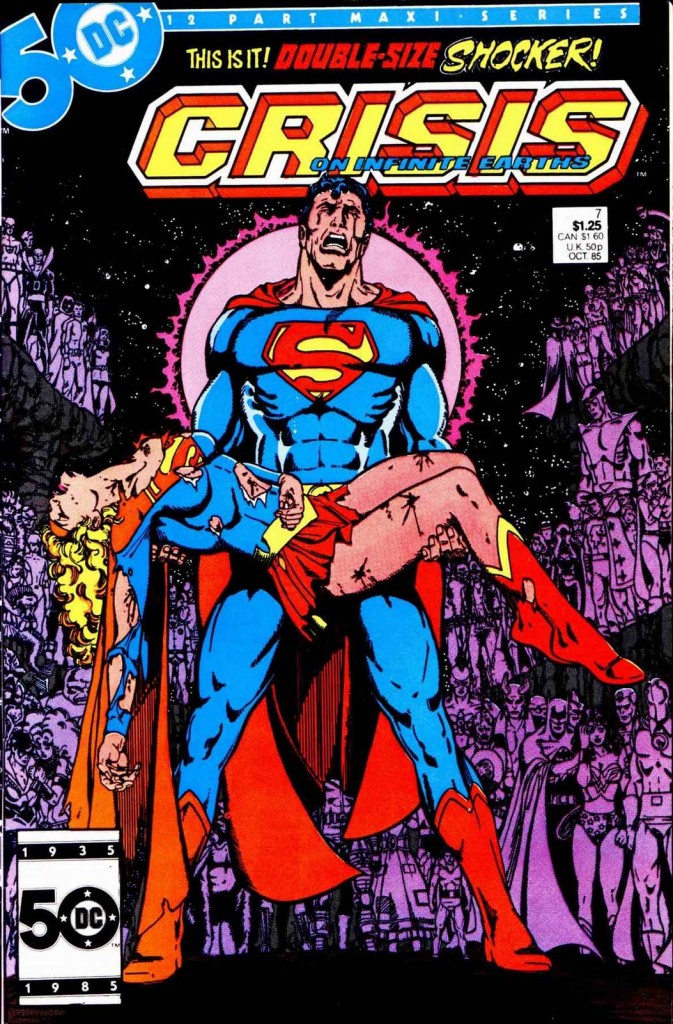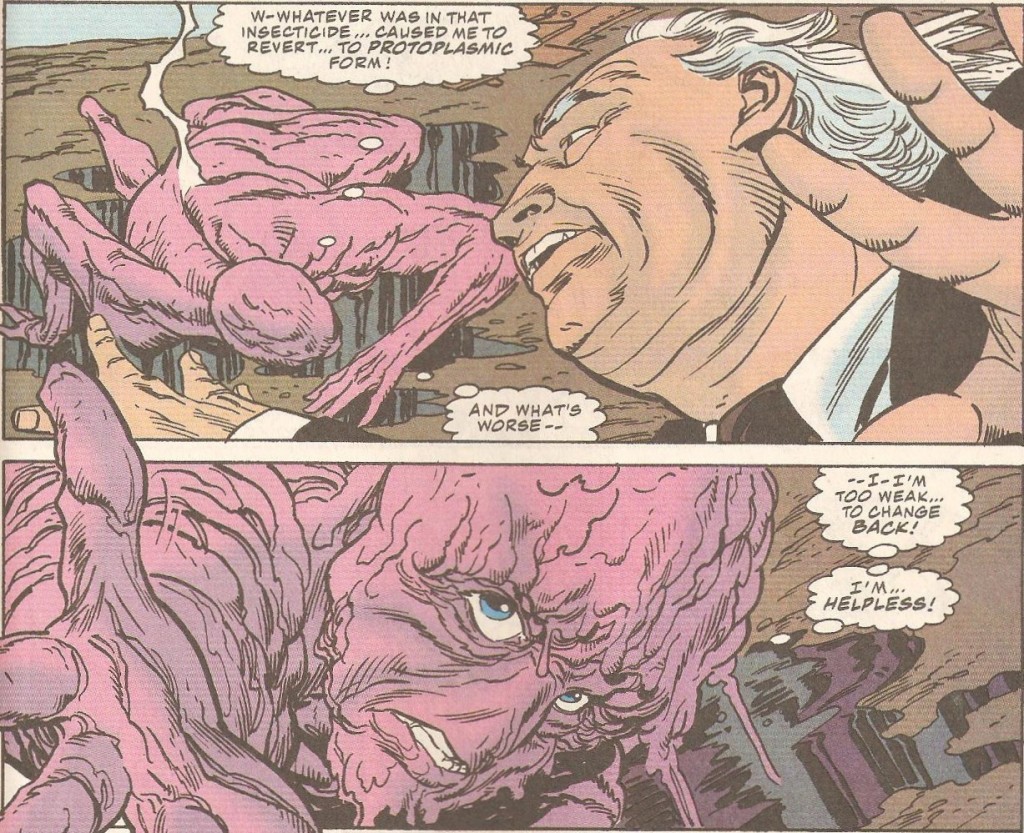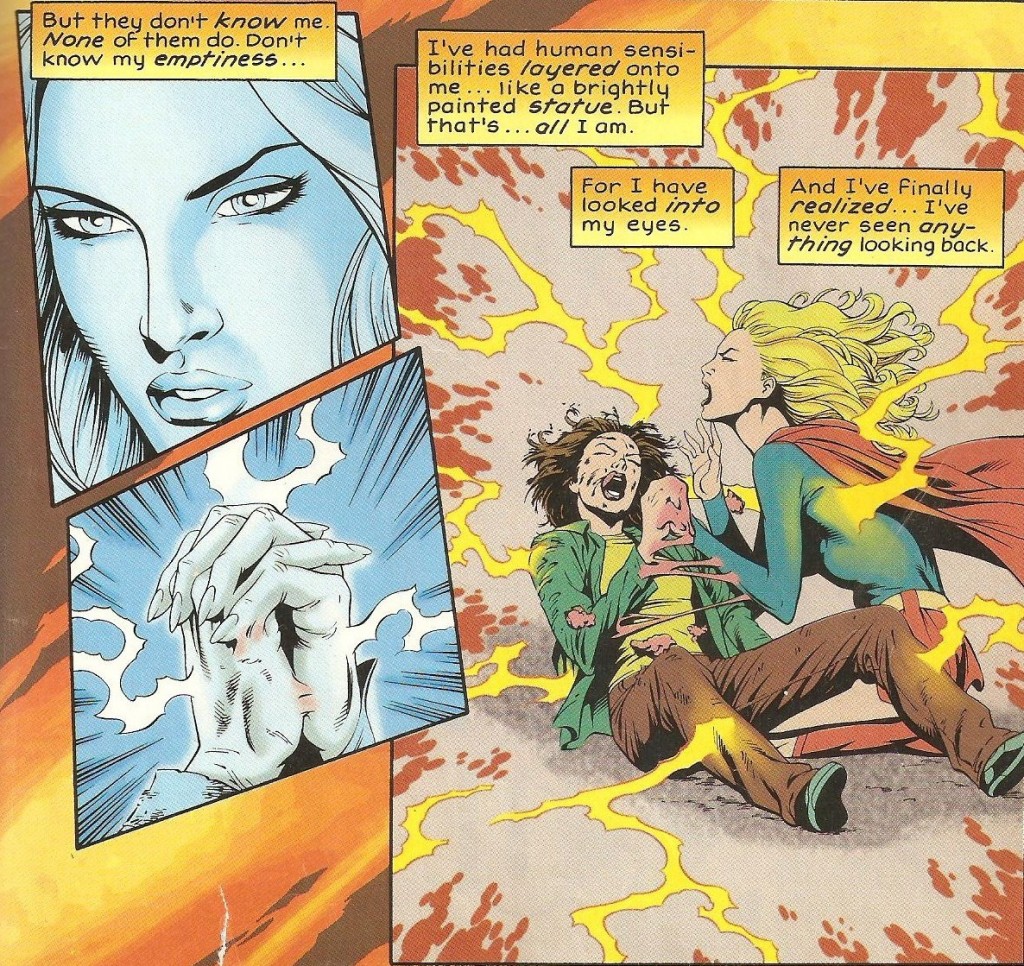Here at DC Histories, we try to make sense of the continuity that perplexes, befuddles, and intimidates. We discuss what worked and what didn’t. This week, we’re talking about the forgotten Matrix Supergirl.
The Crisis on Infinite Earths wasn’t kind to Superman’s cousin, Kara Zor-El. A Kryptonian just like her cousin, Kara had been a resident of the DC Universe since 1959. The DC editorial offices, wanting their Crisis miniseries to make an impact, decided to kill off two major superheroes during the course of the story. In a memorable scene, and even more memorable cover, Supergirl died saving the universe.
When the Crisis finally wrapped up, DC found itself in a bit of a quandary. As we mentioned in last week’s DC Histories: Power Girl, the new continuity would be one in which Superman was truly the last survivor of Krypton. To that end, characters like Krypto and Beppo the super monkey were written out of existence when John Byrne’s Man of Steel miniseries retold Superman’s origin. Supergirl was also left out of the story.
Then, much to the surprise of many fans, Supergirl suddenly appeared in 1988. But this was a Supergirl that no one knew.
That orange hair above is a misprint. This new Supergirl was a blonde, just like Superman’s forgotten cousin Kara before her. Well, this Supergirl was blonde only when she wanted to be. She had a different set of powers than her Kryptonian namesake. Her abilities included telekinesis blasts, shape changing, and invisibility. This Supergirl was known to change her hair color or even her ethnicity with just a thought.
Her real name was Matrix and she was created in an alternate “pocket” dimension by a benevolent version of Lex Luthor. Matrix wasn’t Kryptonian but she wasn’t exactly alien either. Created in a lab by that other version of Lex, she was a sentient mass of protoplasm that could shift her molecules to any shape that was roughly her own size. If Matrix really concentrated, she could gain mass. Doing this would cause her pain, but Matrix would do it when necessary. Switching between genders wasn’t a problem either. When she was in her natural form, she looked like a lump of purple, formless flesh.
She was first released into the regular DC Universe in order to convince Superman to follow her into her pocket universe in order to save it from a Kryptonian threat. After that adventure concluded, Matrix’s mind was damaged, causing her to revert to a very basic humanoid form. Confused and easily lead astray, Matrix was simply unable to care for herself. Knowing that Matrix needed someone to take look over her in this fragile state, Superman left her to be nursed back to health by his parents in Kansas.
When I say Superman “left her” with his parents, I really mean it. During this time period, Superman exiled himself from Earth. His mental state had become fractured. Superman had begun going out at night in the guise of Gangbuster, fighting crime even while he thought he was sleeping. Needless to say, he no longer trusted himself around people. Though he would eventually return to Earth, Superman decided to live the rest of his life in outer space, far from those he loved and could potentially harm.
So, when Matrix found a picture of Clark Kent, took on his form, and showed up in Metropolis with child-like behavior, there wasn’t anyone around to fix that problem. The Daily Planet staff assumed that some enemy of Clark’s had caused his unaware state, so they took Matrix in to help. By the time Superman returned to Earth, Matrix had fully convinced herself that she was Clark Kent. This also meant that she was Superman. She set herself up with a black-and-gray version of Superman’s costume and when the two finally met, it didn’t go well for Matrix.
It was Matrix’s turn to be exiled into deep space still clad in the black-and-gray Superman skin she’d invented for herself. She didn’t plan on returning but, just like Superman before her, she eventually would. Never believe a member of the Super-family when they claim that they’re going into exile. They’re all liars.
After helping Earth weather an attack from both the villain Brainiac and a Death Star knock off named Warworld, Matrix realized that it was the Supergirl look that she most identified with. That was the name and skin she wanted to take from then on. So, Matrix returned to Earth as Supergirl.
Looking back on this moment, it could be argued that the Matrix Supergirl is the first transgendered superhero in mainstream comics. It was a conscious choice for Matrix when she decided on her gender and look. She could just as easily have chosen a male form, like she did when she thought she was Clark, or a sexless form, like when she lived with the Kents. This Supergirl was female by choice because it “felt right.” Save for the occasional shape shift, she would remain female for the rest of her story.
Matrix made her way back to Earth where she met the regular DC Universe’s Lex Luthor for the first time and fell in love. She would become a kept woman, only doing things to please Lex. It wasn’t the high point of the Matrix’s career.
Now, you may see the above image and say, “Lex Luthor? That red headed guy isn’t Lex Luthor!” You’d be wrong. Shortly after Superman’s 1986 reboot, Lex Luthor made himself a ring made out of Kryptonite, which he used it to keep Superman at bay. Normally, Kryptonite is harmless to humans but having the ring on all day everyday caused Lex to slowly develop cancer. So, he cloned himself, aged that clone to be in its mid-20s, faked his own death, and then moved his brain over into the clone’s body. Lex claimed that this new body was actually his illegitimate Australian son named Lex Luthor II. I swear that I will explain this entire thing more in a future article. For now, just roll with it. All that matters is that Matrix thought that our Lex looked like the Lex that created her and she loved him for it.
After a time, Lex convinced Matrix to allow him to put her through a series of tests in order to quantify her powers so that she’d know her limits. She agreed because she agreed to everything Lex asked of her.
Things started off well. Slowly, Matrix noticed that Lex was tricking her by doing tests unannounced and pushing her past her comfort level. Growing a bit suspicious of Lex’s motives, Matrix changed her appearance and went invisible to investigate. All she had to do was pick the right person to look like and walk into the right facility. Eventually, she stumbled across Lex’s real reason for all of these tests. Lex wanted to develop a whole army of Supergirls by cloning her. On the page below, the guy without the bandages is actually Matrix in disguise.
Enraged, Matrix destroyed the clones and confronted Lex. However, at the same time that Matrix realized that Lex was truly evil, a plague had been ravaging all of the clones in the Superman line of books. This plague severely weakened Lex to the point that he couldn’t defend himself against Matrix’s anger. Only the calming voice of Superman dented her rage. Matrix left Metropolis after turning Lex over to the authorities.
At this point, Supergirl dropped off the map a bit. She’d appear here and there in Superman stories but without any real developments. Matrix would join the New Titans during the same time period that Impulse was a member, but it wouldn’t last long. A few years later, during an adventure dealing with demons and occult lore, Matrix found herself physically bound to an innocent teenager named Linda Danvers.
With this merge, Matrix was gone as a character. In this moment, Linda Danvers absorbed Matrix and Linda was in charge now. Linda found that she didn’t have the ability to completely change shape. She could, however, shift between normal Linda and full-on Supergirl.
Full disclosure: I’ve only ever read the first arc of this series. My knowledge of it is fairly limited. I do know that this series had this Supergirl become an angel on Earth. Demons and similar beasties were a common occurrence. In the end, the series ran for a very respectable 80 issues.
This version of Supergirl was completely eclipsed in 2004 when Kara Zor-El came on the scene. After arriving in a Kryptonian rocket, Superman’s cousin was introduced back into continuity and Matrix became nothing but a memory in the mind of both the DC creative teams and many readers.
Kara Zor-El is still Supergirl in the New 52. Matrix hasn’t been seen or mentioned in years. Still, with all of the 1990s ideas and concepts coming back into vogue at DC, can Matrix be far behind?
Well, yes. But, I’m still holding out hope.
Jeff Reid loves Superman comics from 1986 through 1995 or so. That will always be “his” Superman. Tell him which is “your” Superman below or on Twitter.













Linda Danvers, eh?
I’m surprised they didn’t use her as the “Nexus” for the DC-Marvel crossover
I didn’t know anything about this “Supergirl” before reading this…these DC Histories are great!
Peter David took her with him to the Fallen Angel series he did, first for DC then IDW.
I’ve been maining to read that Linda Danvers Supergirl series written by Peter David for quite some time (the art teams on it sound tremendous). I remember reading a synopsis on it referencing the Matrix, and asked myself what the hell was that?? Thank you for answering my trivial-yet-important query, Mr. Reid.
I only know of her because she shows up on the Death of Superman TPB for like two seconds
That’s almost certainly the extend of most people’s knowledge of her. The red-headed Lex Luthor also showed up in that story, which I’m sure threw tons of readers off.
yeah, she played a fairly large role in the funeral for a friend, return of superman storylines. there was also the post- Matrix, pre- Kara ZorEl (2004) Supergirls. I believe one was blonde with a white shirt like the animated series, and one was a black haired Supergirl who I think was from the future.
Great article Jeff. I was vaguely familiar with some of the details, but I’ve never had the opportunity to read a pretty much any of it save for what was in the Death of Superman/Funeral for a Friend.
I believe Superman took on the guise of Gangbuster not Guardian at night. It was his fight against Guardian that exposed the Superman costume hidden underneath the Gangbuster costume and brought him out of his confused state causing him to see himself as a danger to humanity and exile himself to space. This was the story line going on when I first started reading mainstream comics.
Gah! You’re right! It was Gangbuster not the Guardian. I got my G-named powerless superheroes confused. I’m changing it now.
If memory somewhat serves me, Gangbuster initially was somebody else before Superman had a (wait for it)…. identity crisis.
I much prefer the classic Supergirl costume over the midriff version. Jackson Guice’s art is awesome in those Superman books.
i remember reading a scene in my Death of Superman trade where Supergirl shows up only to get wholloped by Doomsday. After getting hit she turned into a big purple blob. I always wondered what was up with that. Thanks for explaining it Jeff
I liked the Matrix character. I remember reading stories here and there involving her and I enjoyed the out there concept. I liked the Linda Danvers stories too until it got into the angel and her horse-man boyfriend.
See you learn something new every day. I had no idea about this but now Jeff made me smarter! Bravo for making this article good sir.
This era of Superman is when I started reading comics. I really enjoyed them. They were a great soap opera, and it was the first time I encountered a weekly comic. (There were 4 Superman titles, one a week, all following the same story).
That was a great time period. Eventually, the Superman line got even another title to fill in on the quarterly “fifth week.” A new Superman comic for 52 weeks in a row is quite the accomplishment. Too bad it didn’t last.
PAD’s Linda Danvers Supergirl series is one of my absolute favourite runs in comics. No joke.
I’ve got to get my hands on that series one of these days.
It was one of the best series in the 90s.
I second that. It did something completely different. and a must read. Also if you enjoyed that I recommend The Specter
I just remember Gary Frank’s killer art. Everything else about this character is just a playlist of the worst aspects of DC in the 90’s, not the least of which was Luther Clone McGillicuddy. .
Fine article, really interesting. I doubt, though, that I’d ever want to read about the Matrix’ comeback.
Man, I loved Matrix Supergirl. I thought it was a really interesting concept and they used her really well during and in the years following the death of Superman. The Lex/Supergirl relationship was a neat dynamic. I’ve only read a few issues of that Supergirl run, but had a lot of great ideas and I definitely want to read more of it someday. (And that Gary Frank art was so awesome that as a kid it’s one of the first comic book things I tried tracing to see if I could learn something.)
Two things about this run. One personal, the other canon. First: I have always been repulsed by the idea of Supergirl (or ANY female DCU protagonist ) giving herself in bed to Lex. And second: the original Matrix form was created from the last life essence of that ‘pocket’ universes’ Lana Lang by a Luthor with a good heart. …Just one more sacrifice the friends of that world’s Superboy had to make. Sad.
i agree.Peter David’s run on Super Girl was well written.No chance of Linda Danvers coming back to DC Universe? that would be great.